Fermented lemons are quick and easy to put together, and they make the citrus season last the whole year through! Also known as preserved lemons, this recipe uses only salt and the lemon’s own juices. These morsels are a delicious way to keep lemons ready for use in cooking when you need them.
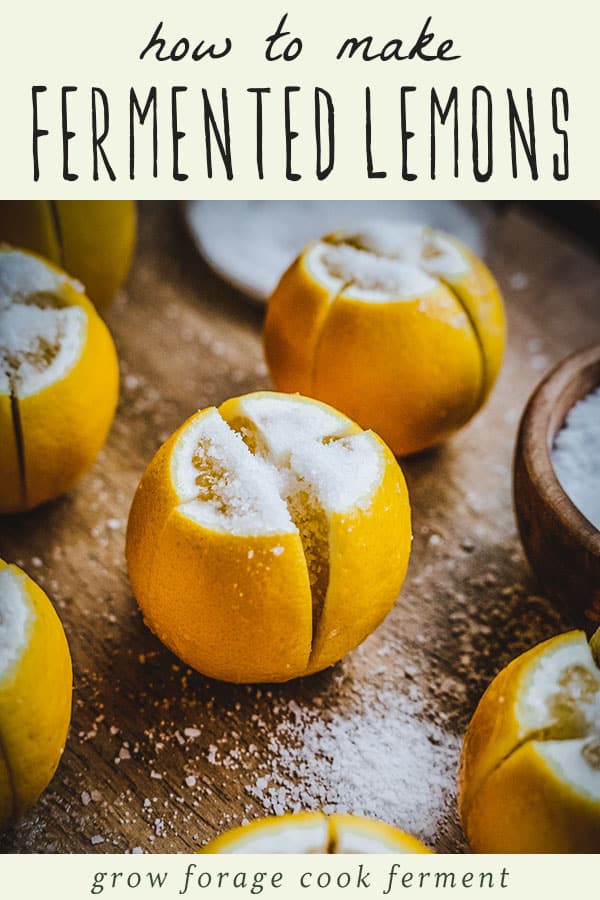
What are Fermented Lemons?
If you ever run across a recipe that calls for preserved lemons, what they mean are fermented lemons. While they seem sort of fancy and are often considered a delicacy, they’re actually quite easy to make.
Fermenting is my absolute favorite way to preserve food, and these lemons are no exception!
Fermented or preserved lemons are lemons that have been packed into a jar with salt, where they ferment for several weeks in a process called lacto-fermentation.
Fermentation preserves the lemons and results in a delicious condiment bursting with flavor and beneficial bacteria that are good for the gut.
Related: 12 Ways to Preserve Citrus: Drying, Canning, Fermenting and more!
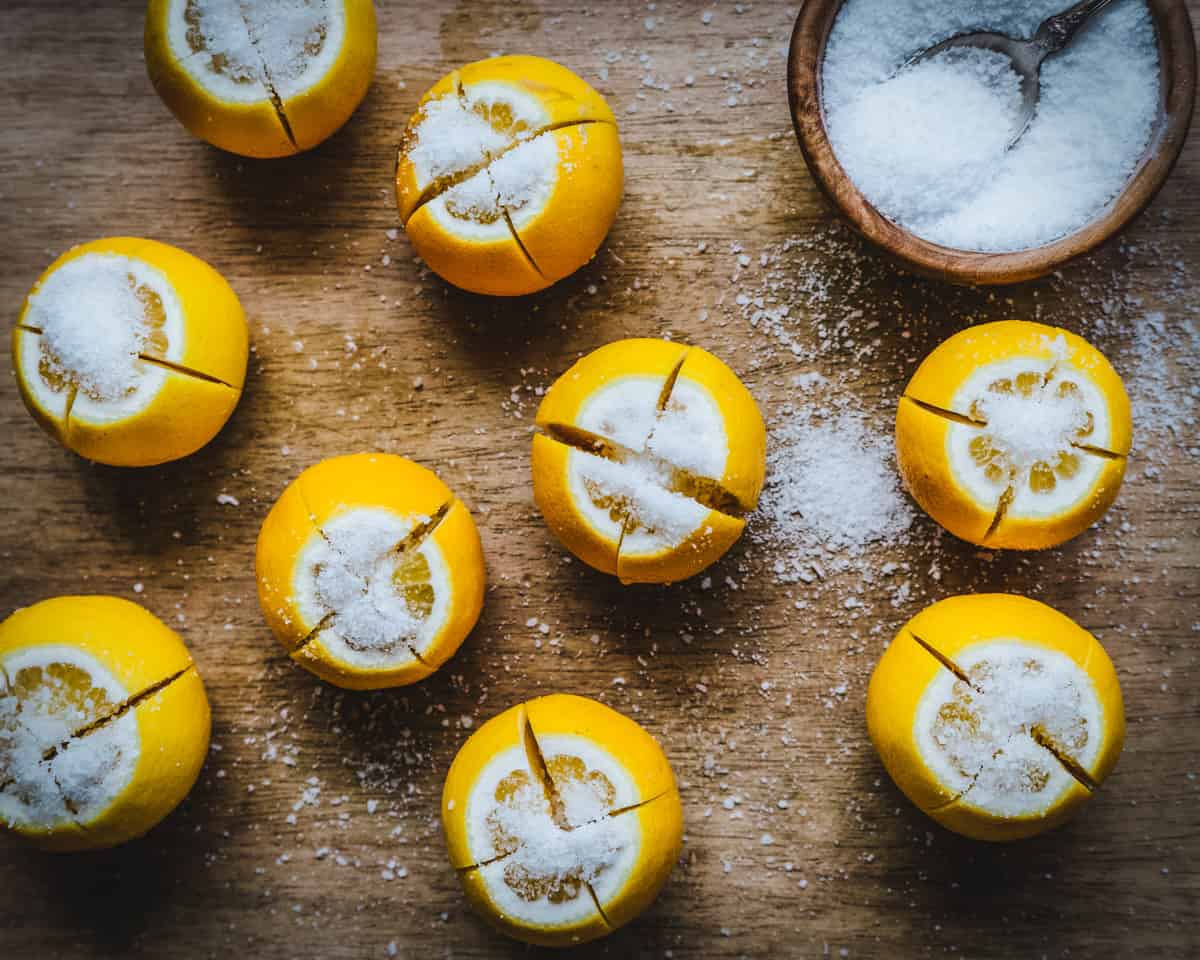
Fermenting Lemons in Salt Recipe
All you need is lemons, salt, a jar, a fermentation weight, and as always with fermented recipes, time is the best ingredient!
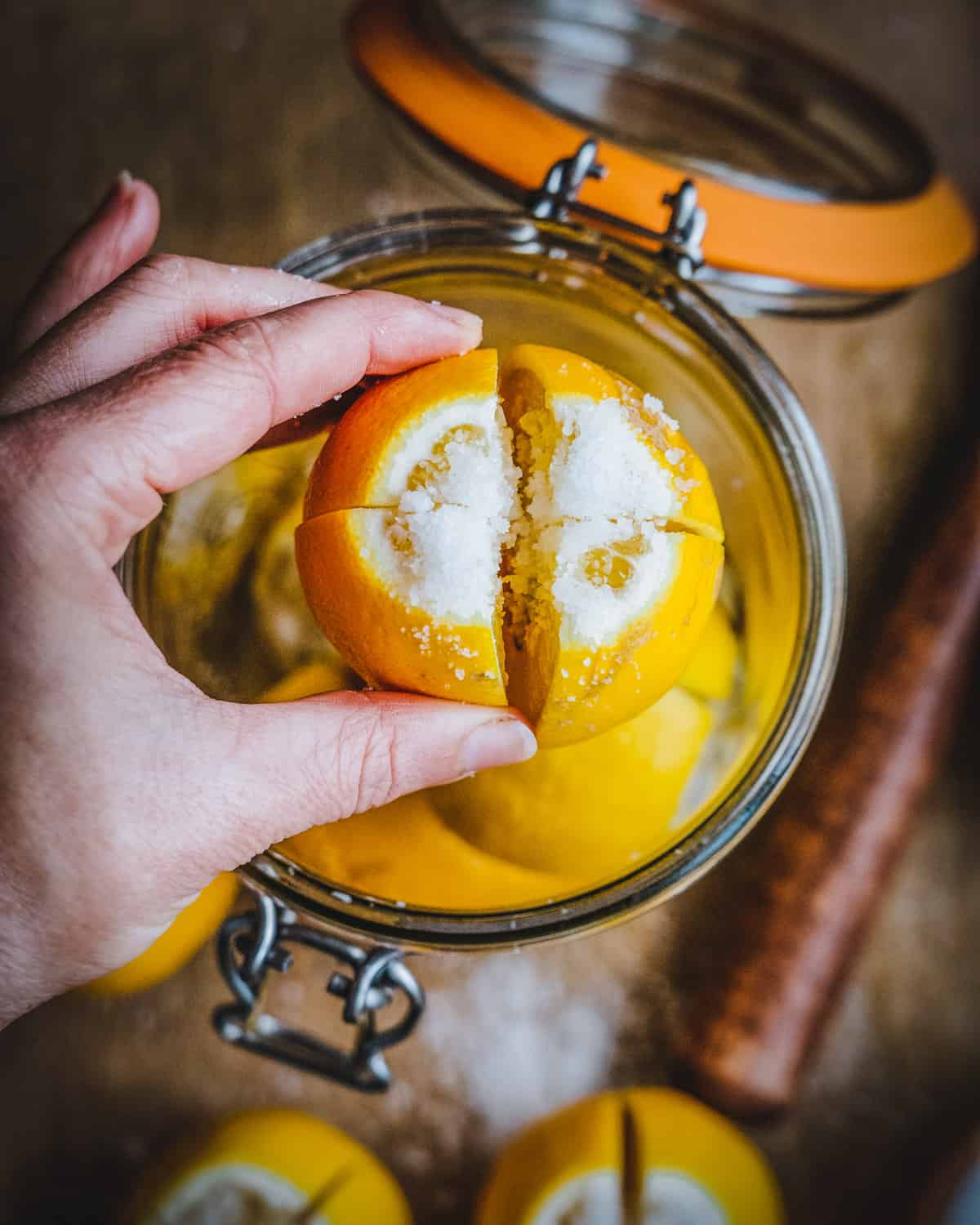
Prepare the Lemons
First, wash the lemons and give them a good scrub to thoroughly clean them.
Then, trim the top and bottom of the lemons by cutting about ¼ inch off on each end. Slice the lemons lengthwise into quarters, leaving the last ½ inch connected at the base.
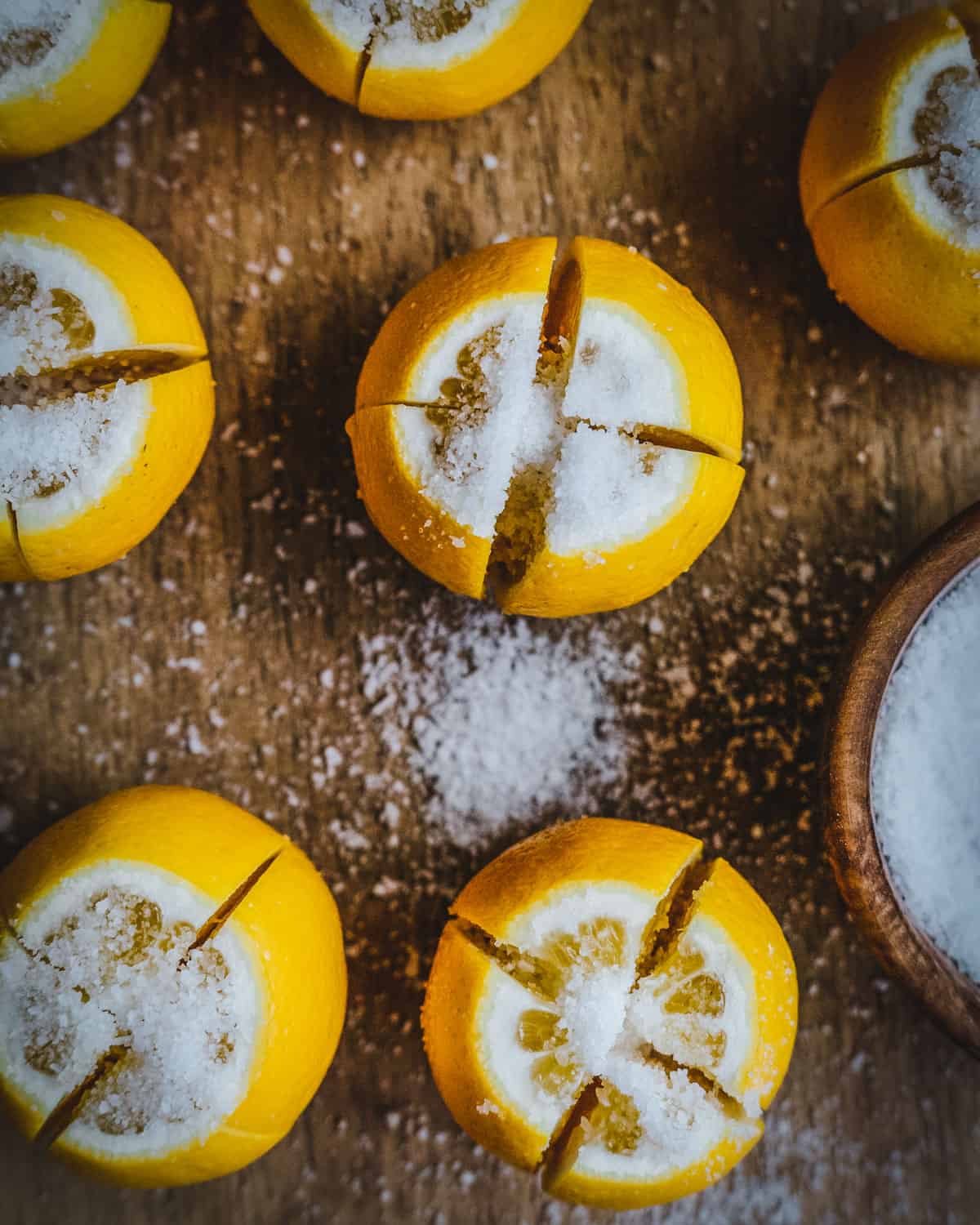
Add salt to the lemons
Gently open the lemons and sprinkle the inside flesh with about a teaspoon of salt. Place 1 tablespoon of salt on the bottom of a 1-quart jar.
Pack the lemons into the jar tightly using a wood muddler. Add more salt as you go, pressing the lemons down to release their juices and make room for the remaining lemons.
Feel free to add a couple of bay leaves and a tablespoon of peppercorns if desired, but this is optional.
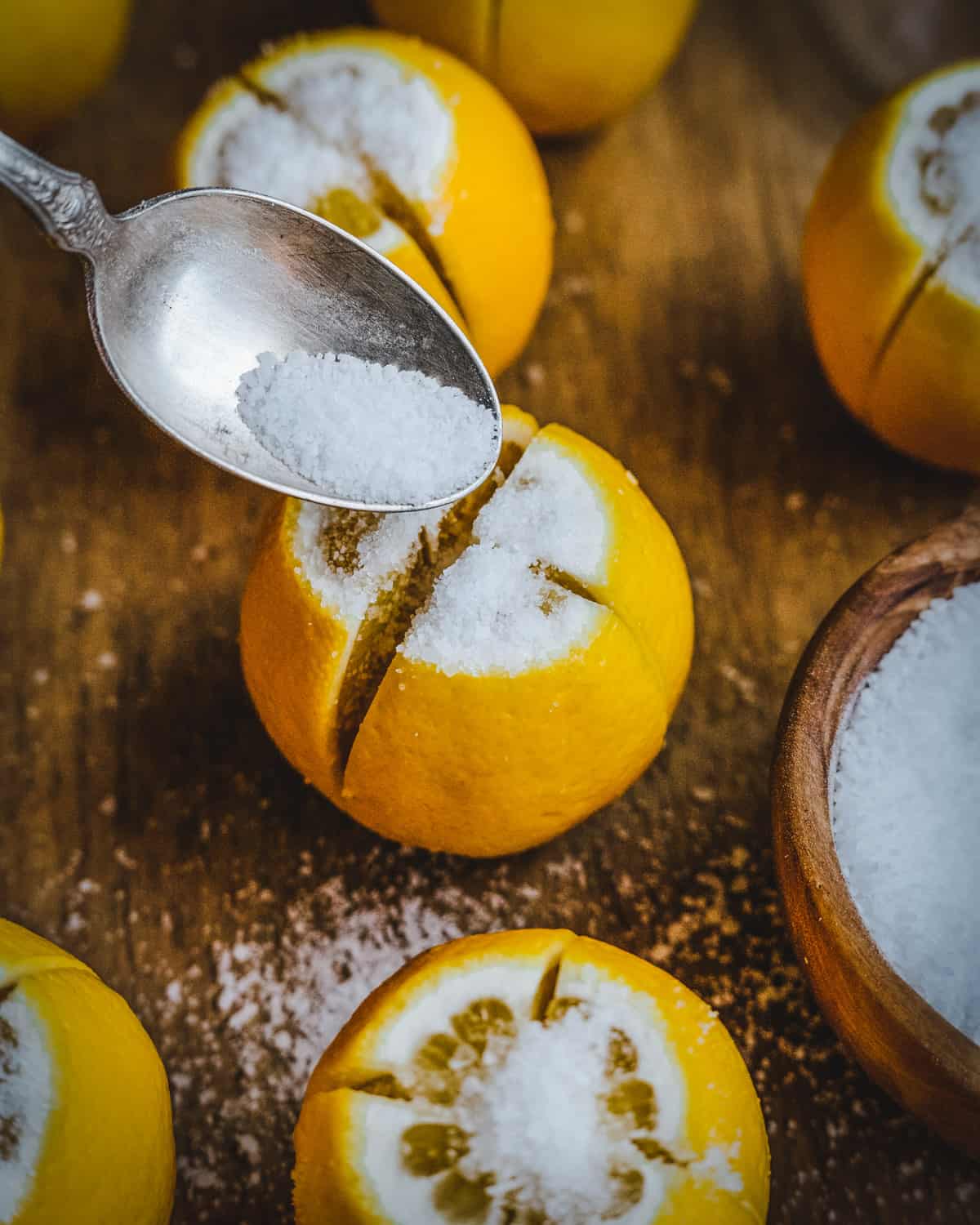
Press the lemons down tightly in the jar so that the lemon juice and salt combine to make a brine. Add freshly squeezed lemon juice from about 2 lemons so that the lemons are completely covered in juice.
Then add a fermentation weight on top to keep the lemons submerged while they ferment.
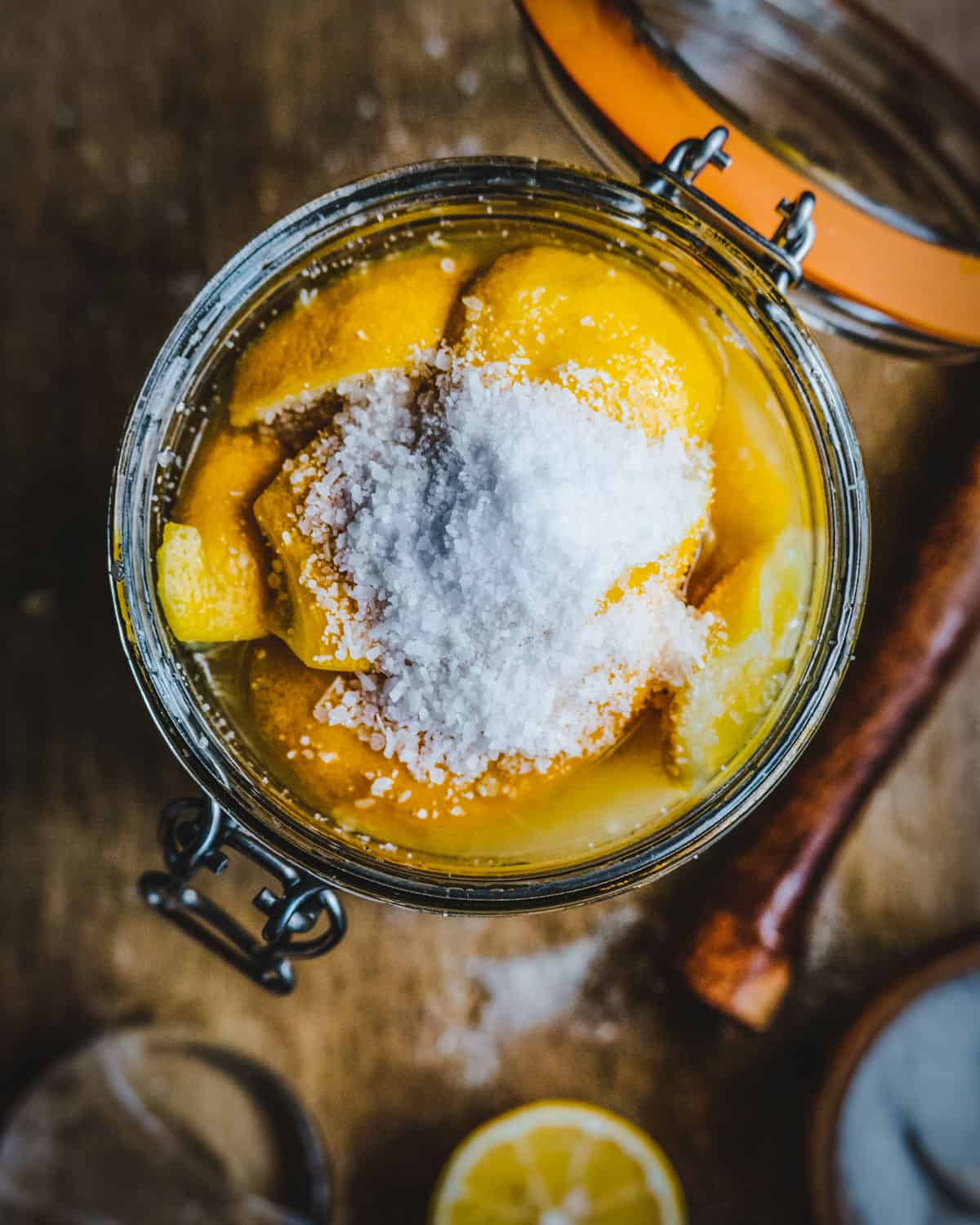
Cover and flip the jar
Close the jar and allow the lemons to ferment at room temperature for about 4 weeks. Turn the jar upside down every so often to distribute the salt and juice.
The lemons will soften and mellow as they sit in the pickling liquid.
The lemons are ready once they soften, and the pith loses its bitterness.
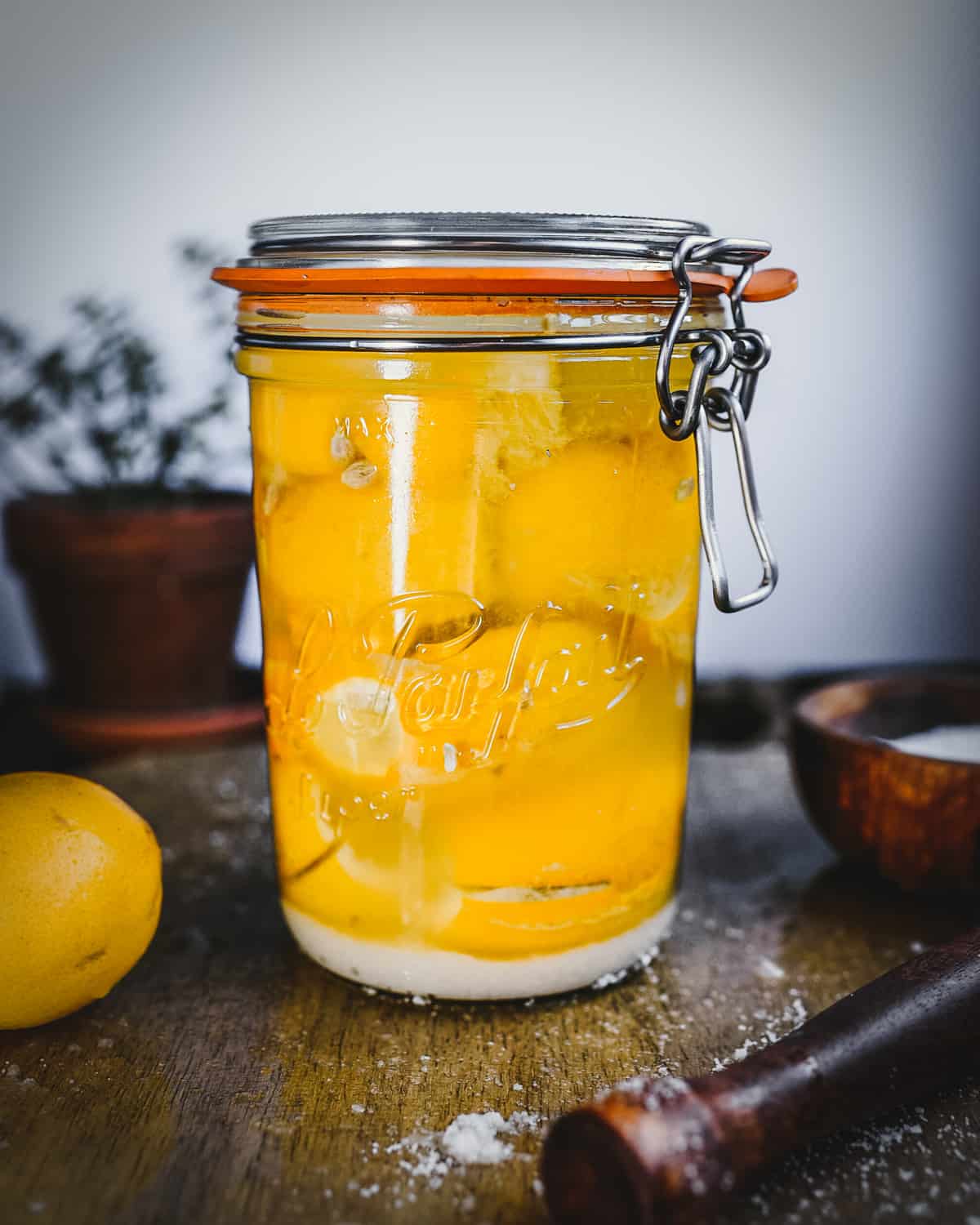
Remember to burp the jar occasionally as it ferments, especially during the first two weeks. Some juice may bubble out so keep a plate or other dish under the jar to catch any drips.
I didn’t experience much gas buildup compared to other fermentations. You can use an airlock fermentation lid if you would rather skip having to burp the jar.
Taste and feel the lemons after they have been fermenting for several weeks, you will feel if they have become softened.
Once they are soft, and there is no more detectable bitterness, they are ready to use.
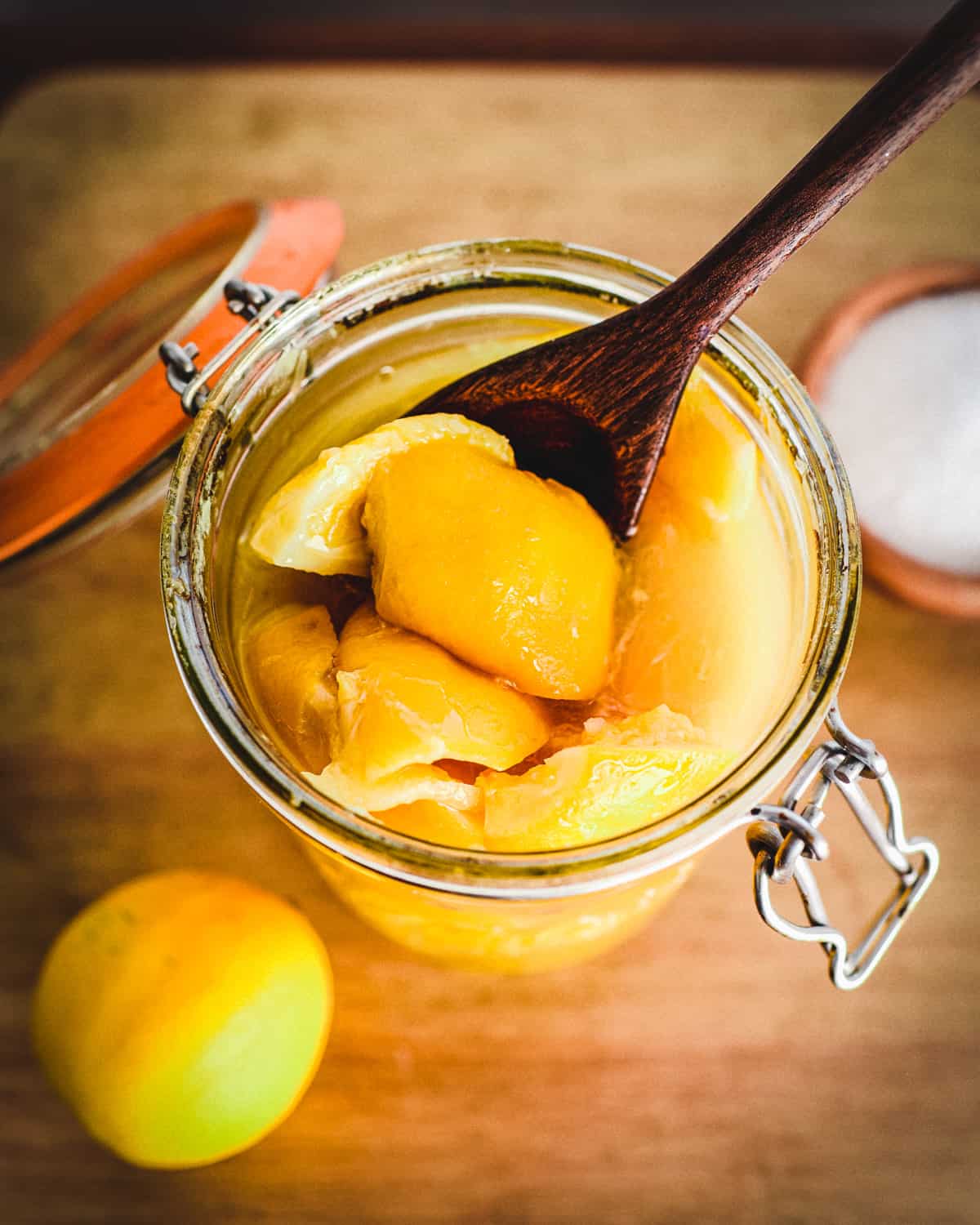
How to use and store fermented lemons
To use, rinse the lemons as needed with water to remove some of the salt.
You can remove and discard the pulp and use just the peels, or use the entire lemon. It’s all delicious!
Preserved lemons will keep for six months to a year. Store them in the refrigerator or at room temperature.
The salty, acidic brine that is created during fermentation acts as a preservative, so as long as the lemons are submerged they won’t spoil.
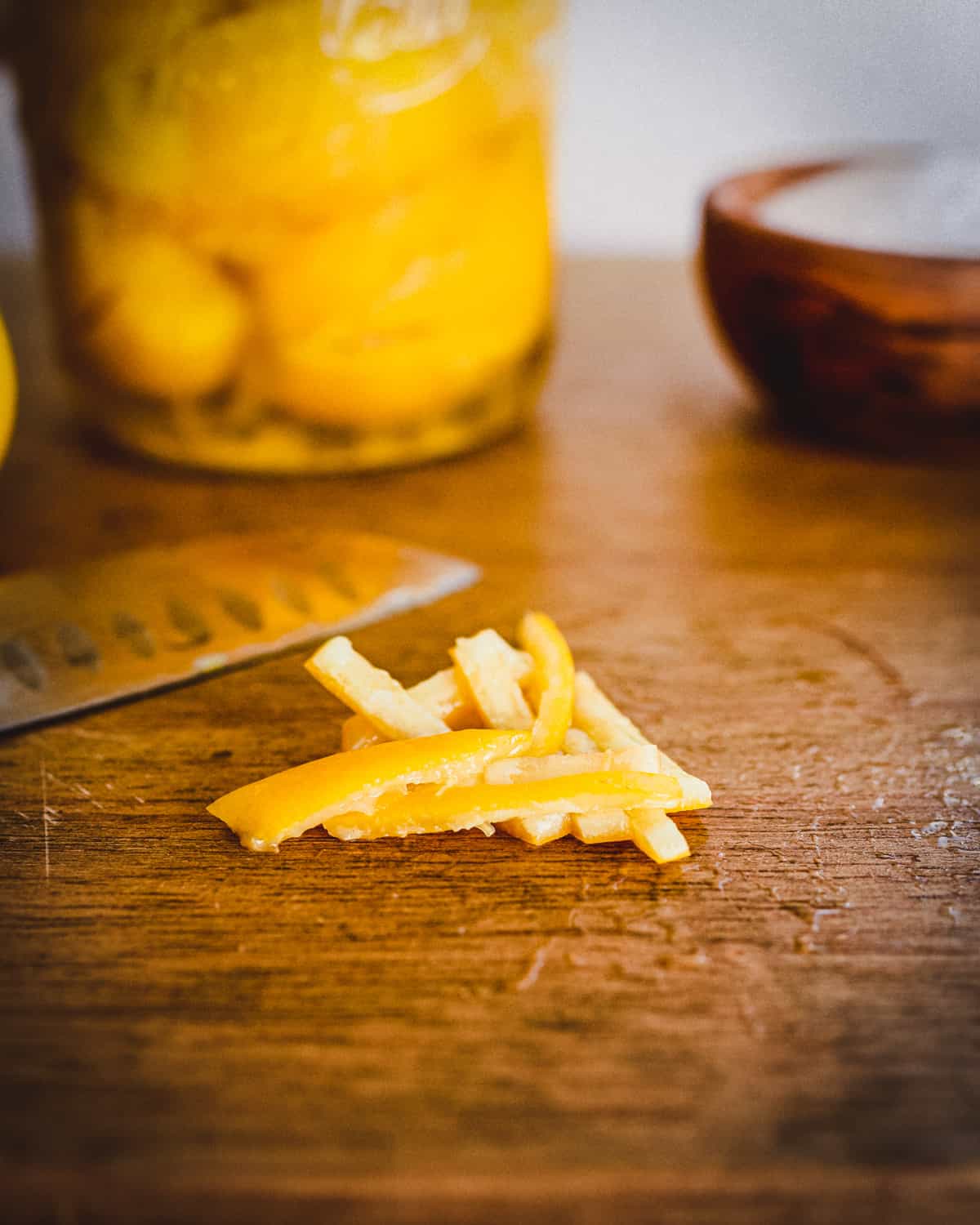
FAQ’s
What do fermented lemons taste like?
Once preserved, the lemons have a silky texture and pleasant taste that is a perfect blend between tart and salty. Fresh lemons cannot replicate the unique taste of fermented lemons.
I would describe their flavor as bright, citrusy, and salty.
What kind of lemons are best for this recipe?
You can use any variety of lemon for this recipe, but Meyer lemons are a common choice since their skins are thinner which makes for a shorter fermenting time. Their taste is also a bit sweeter making for a lovely flavored finished result.
Regular lemons are fine to use, but note that their skins will take longer to soften and lose their bitter flavor during fermentation.
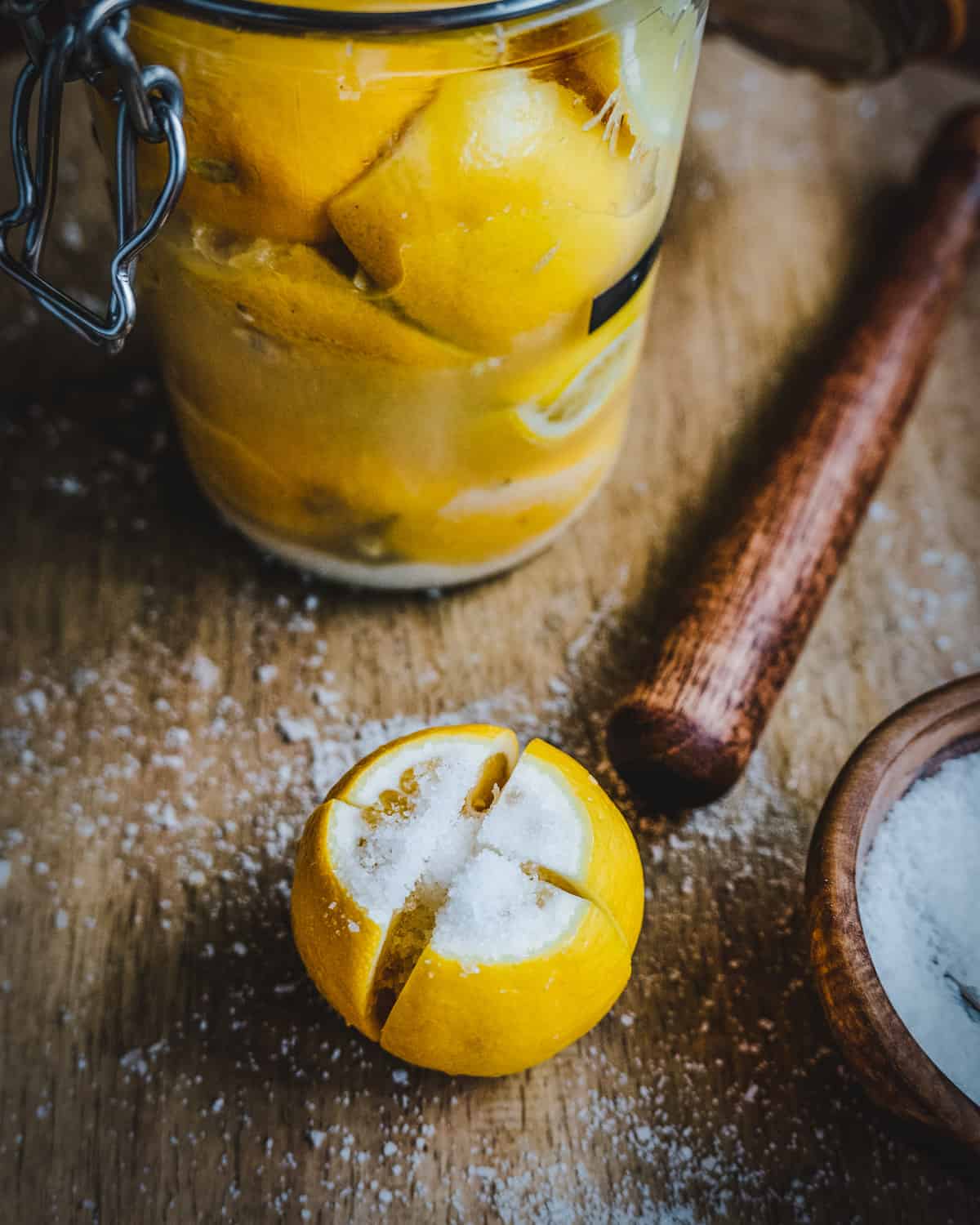
How do you use them once they are ready?
You can use the flesh and rind of fermented lemons, but the rind is the most delicious part! It loses all of its bitterness during fermentation and has an almost sweet flavor that works well in many dishes including common use in Morrocan cuisine.
These tasty salted lemons work wonderfully to season chicken, fish, and tagines. They also go particularly well in seasoned roasted veggies, soups, vinaigrettes, and as a salad topper.
How long do preserved lemons last?
Preserved lemons can last from 6 months to a year, either in the refrigerator or safely stored at room temperature.
A salty and acidic brine is created during fermentation and acts as a natural preservative to keep the lemons from spoiling. Making sure the lemons stay submerged in the brine is important.
What is the difference between fermented lemons and pickled lemons?
Fermented lemons and preserved lemons are the same as pickled lemons. All three use the same salt-cured technique.
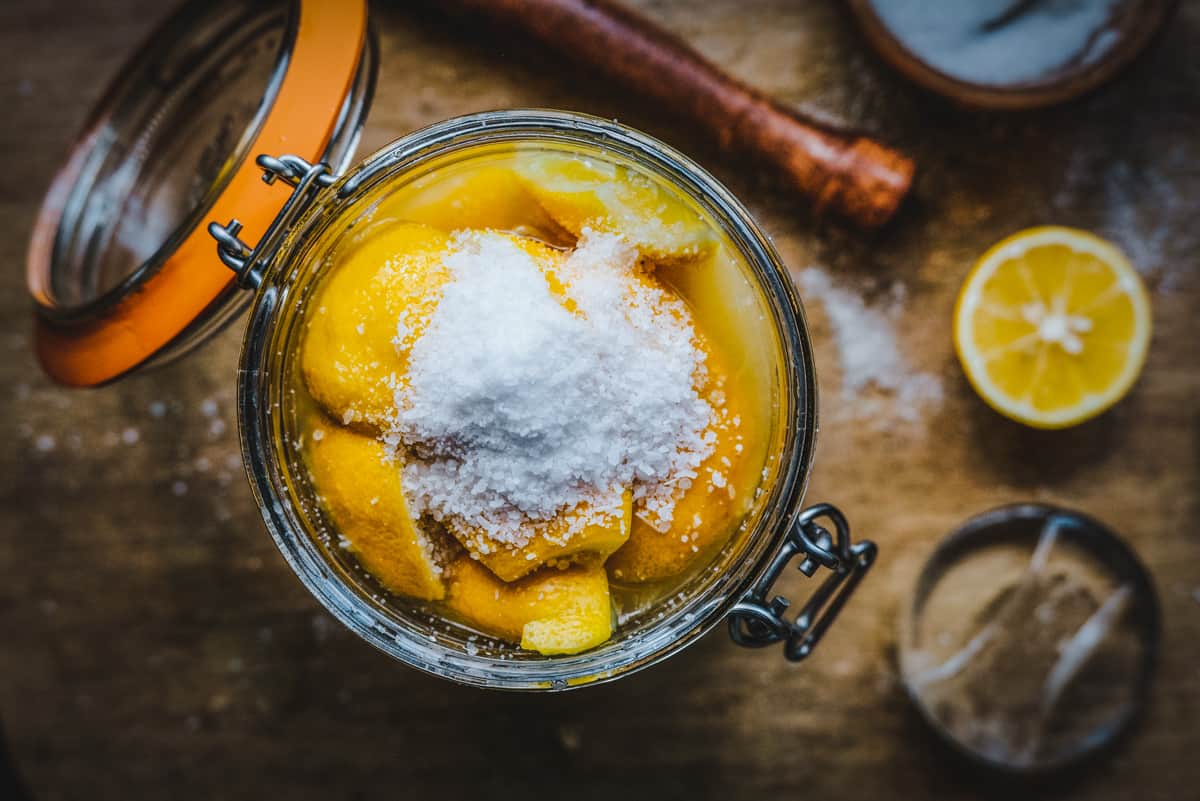
Should I worry about botulism?
Botulism is really not a concern with fermented lemons, just like any other lacto-fermented food. Low-acid canned or preserved foods are sometimes a concern for botulism, however, lemons are too acidic and aren’t a host for the toxin.
Lemon juice adds acidity for the prevention of botulism in canning recipes. So rest assured, this recipe is safe and worry-free.
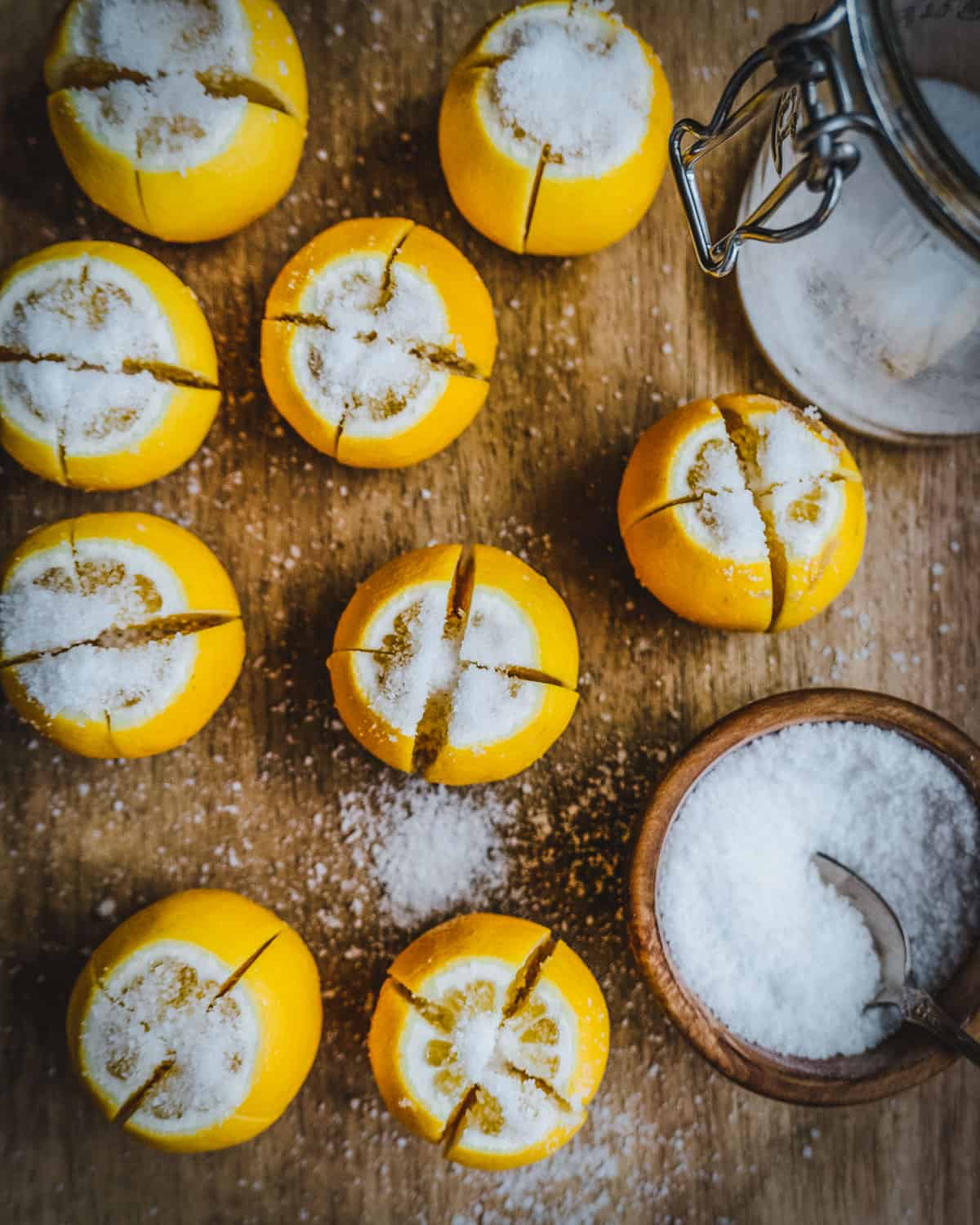
More Lemon & Citrus Recipes
Love lemons? Then you’ll love these zesty citrus recipes!
- Lemon Lavender Shortbread Cookies
- Lemon Rosemary Shortbread Cookies
- Plum & Lemon Upside Down Cake
- Lemon Bars with Honey & Thyme
- Grapefruit Curd: Homemade Citrus Curd
- Dried Orange Slices for Food and Decoration
Fermented Lemons (Preserved Lemons)
Equipment
- Fermentation Airlock optional
- Wood Muddler or wooden spoon
- Fermentation Airlock optional
Ingredients
- 10 lemons
- 1/2 cup coarse sea salt non-iodized
- bay leaves optional
- peppercorns optional
Instructions
- Wash the lemons and give them a good scrub to thoroughly clean them.
- Trim the top and bottom of the lemons by cutting about ¼ inch off on each end. Slice the lemons lengthwise into quarters, leaving the last ½ inch connected at the base.
- Gently open the lemons and sprinkle the inside with about a teaspoon of salt. Place 1 tablespoon of salt on the bottom of a quart jar. Pack the lemons into the jar tightly using a wood muddler. Add more salt as you go, pressing the lemons down to release their juices and make room for the remaining lemons. Optional: add a couple of bay leaves and a tablespoon of peppercorns if desired.
- Make sure the lemons are pressed down tightly in the jar so that the lemon juice and salt combine to make a brine. Add freshly squeezed lemon juice (of about 2 lemons) on top to completely cover the lemons in juice. Add a glass fermentation weight on top to keep the lemons submerged while they ferment.
- Close the jar and allow the lemons to ferment at room temperature for about 4 weeks. Turn the jar upside down every so often to distribute the salt and juice. The lemons will soften and mellow as they sit in the pickling liquid. The lemons are ready once they soften, and the pith loses its bitterness.
- Burp the jar occasionally as it ferments, especially during the first two weeks. Some juice may bubble out so keep a plate or other dish under the jar to catch any drips. Use a fermentation lid such as an airlock if you would rather skip having to burp the jar.
- To use, rinse the lemons as needed with water to remove some of the salt. Remove and discard the pulp and use just the peels (though the flesh can also be used if desired).
Notes
- Preserved lemons will keep for six months to a year. You can store them in the refrigerator, however they can also be stored at room temperature. The salty, acidic brine that is created during fermentation acts as a preservative.
- The pickling juice can also be used over the course of a year. Just leave enough juice in the jar to always keep the lemons submerged in the brine.




I thought this might be too salty for fermentation LAB to go.
Nope. Mine fermented just fine.
I want to ferment the lemons in a fermenting crock. It’s very heavy and I would not be able to turn it upside down. Would I then stir the lemons occasionally instead?
Also, I suggested your book for the library here in Coquitlam BC Canada. It was approved and ordered, and I like it so much I’m heading out to buy it today!
Personally, I wouldn’t use a crock for this recipe. Any time you introduce a foreign object into the crock, you’d be risking cross contamination.
I received ponderosa lemons as a gift. However, they are too big to fit into the mouth of the jar. Can I cut the lemons to fit in the jar and follow the same process?
Yes, that should be fine!
Thank you so much.
After the fermentation, is it possible to can these lemons? I have a steam canner and was wondering what the processing time would be? Thank you
Hi there. You could can them, but you’d lose all the good bacteria you cultivated during the fermentation process, so I don’t recommend it. Fermented foods are naturally preserved and will last six months to a year when properly stored.
I have made these a few times but as lemons are removed the juice no longer covers the remaining lemons. Can I top up with more lemon juice?
Yes, that’s fine!
Sounds wonderful! Never heard od fermented lemons before – but I defenitely need to try this. Thank you.
You’re welcome. Enjoy!
When making Preserved Lemons what is the least amount of salt I need to add???
Hi Cat. You’ll need to use 1/2 cup of salt for this recipe as the salt is what preserves the lemons.
I.m trying this but am curious on what happens if I I don’t have the weight. I’m also curious about recipes that I can use this in.
Hi Jill. You can improvise with a zip-top bag filled with water about a quarter or a third of the way.
Would the Ball Fermenting jar kit with the metal spring be okay to use for this recipe as well (instead of a glass fermentation weight)? Or would it (the metal) react poorly because of the high acidity in the lemons? Any advice?
The Ball Fermentation jar kit would work wonderfully with this recipe!
I don’t have an excess of citrus here in zone four, but I like to take orange or lemon peels and just add them to a sandwich bag with sugar. The oils come out and flavor the sugar and I use that mostly to add to teas.
This looks delicious. I can’t wait to try them. Thank you for sharing.
You’re welcome! Enjoy!